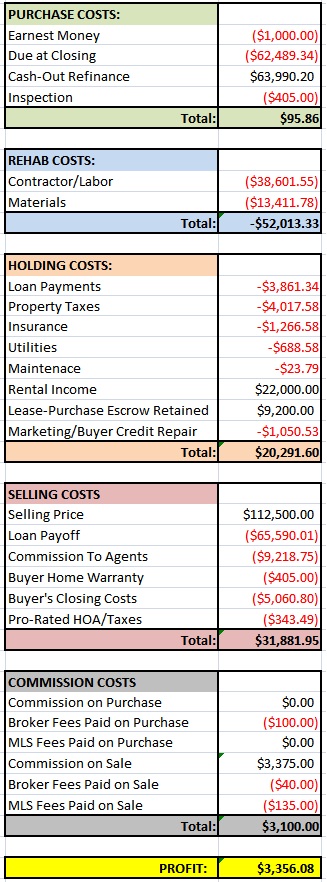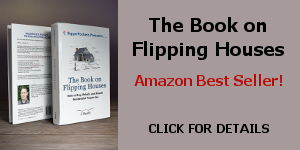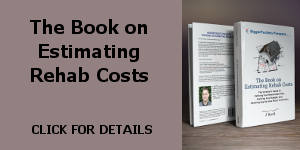We closed on The Corn House yesterday…
For those following this blog since the beginning, you may recall that this was the very first house we purchased, more than two-and-a-half years ago. Back when we were originally considering this property as our first investment, my wife and I said to each other, “The goal is just to break even on this one!” And that’s pretty much exactly what we did.
While the other two dozen or so houses we’ve bought and sold in that time have been very profitable (all but one have hit our minimum $15K profit target for flips and $5K profit target for wholesale deals), this one just barely eeked out a small profit (and it easily could have gone the other way!). We made a lot of mistakes on this property — I have an upcoming post that will touch on many of them — and while it was a tremendous learning experience and a stepping stone to the success we’ve had, it’s also been an endless source of frustration and annoyance over the past two years.
So, I guess what I’m saying is, I’m glad to be rid of this house, and other then the lessons I’ve taken from it, I hope I don’t have to think about it again for a long, long time… 🙂
On that note, let’s jump into the final analysis, and remember that because we rented this one for two years, some of the numbers are skewed…
Timelines
Because we rented it for two years, this was by-far the longest we’ve ever held a property; in fact, even if we hadn’t rented it, the holding time likely would have been quite long. Because we listed this one on two separate occasions (back in 2008 and then again last month), I’ve included two dates for a couple of the milestones below.
Here are the key timeline milestones:
- Purchase Offer Date: 7/24/2008
- Purchase Closing Date: 8/13/2008
- Rehab Completion Date: 10/17/2008
- Sale Listing Date: 10/18/2008 & 3/9/2011
- First Sale Contract Date: 2/9/2009 & 3/19/2011
- Final Sale Contract Date: 3/19/2011
- Sale Closing Date: 4/28/2011
Financials
Here is the breakdown of financials for this project:

We will clear about $3400 on this project (after including unpaid utility bills we’re waiting to receive and insurance refunds). Given that we earned over $30K in rent payments and lease-purchase fees, you can see how easy it would have been for us to actually lose money on this one. Of course, we did do two rehabs as opposed to one, so that added a good bit of expense.
It’s hard to determine our exact ROI on this one, as we refinanced about 8 months ago, so the amount of investment I’ve had in the deal has changed at different points in time; at some point I’ll do a Internal Rate of Return (IRR) calculation, but I’m quite sure my ROI will be very low, regardless of how I look at it. For this analysis, I’m going to estimate that my total ROI was about 8% and my annualized ROI was about 3%.
If my wife wasn’t licensed and if we had to pay a 3% commission to another agent to sell it for us, we actually would have lost a little bit of money on this project. Luckily though, we can say our streak of profitable deals is still alive at 20 in a row…
Final Statistics
Here are just some of the final statistics that I’ve been tracking for all my projects, and that summarize the success/failure of each project pretty well:
- From Offer to Purchase Time: 20 Days
- Rehab Time: 65 and 8 Days
- Selling Days on Market: 10 Days (this was for the second listing)
- Selling Close Time: 40 Days
- Total Hold Time (Close to Close): 988 Days
- Total Profit: $3356.08
- Return on Investment (ROI): 8.20%
- Annualized ROI: 3.03%




Good Morning J,
I’m curious as to how you determine to replace rough plumbing in a house. Is it a FHA requirement with new loans that houses built in 60s-90s with polybutylene be replaced or is this something you simply do if you are doing a full rehab? Thanks
Hey Josh –
FHA won’t require polybutylene plumbing to be replaced unless it has failed (or there’s an indication that it’s about to fail). That said, many inspectors will highlight the poly in the inspection report, will give additional pamphlets on the risk of poly plumbing, will mention the fact that “it will eventually fail,” etc. All these things have a high likelihood of scaring the buyer to the point where they demand we replace it before they close on the property. Given the fact that it’s much less expensive to replace the plumbing during the rehab (when the house is ripped apart), we prefer to just do it upfront. Unless we’re wholesaling to another investor, we always factor in the cost to replace the poly and always do the work.
The new plumbing is actually a good marketing/selling point as well…
Hi!
I absolutely love your site and all the information that you provide. I am currently in the process of doing tons of research so I too can start my own investment company flipping houses. i”ve searched all around your site and others, but no one has given any information on how they started their companies financially. Is it solely off of good credit and personal savings, or is there some type of business loans that I should look for? How did you initially finance this first property? Any information or advice you can provide on this matter would be greatly appreciated. Thanks and I look forward to hearing from you soon.
8.20% ROI isn’t too shabby for your first one. Looking back, would you still have done 2 flipping projects at once?
Hey Nico –
In retrospect, doing the two rehabs at the same time wasn’t at all a problem. We used different contractors and it was like getting twice the learning experience in half the time. The big thing we would have done differently is we wouldn’t have bought House #1. It wasn’t a great deal, and we were a bit too anxious to just get something under contract.
That said, buying that property jump started everything we’ve done since, so maybe it wasn’t too bad of a decision… 🙂
Just want to say thank you for the honesty and willingness to share your experiences. My wife and I purchased 2 of your books (The book on flipping houses and The book on Estimating rehab costs). We are at the beginning of our journey into the housing market, and enjoy the books and website. Thanks again
I want to piggy back Shareena’s question about finance. Did you borrow with good credit? Did you have cash on hand for the Down payment and rehab costs? Details here would help us greatly!
Hi Erica,
If you’re going to borrow from a bank, you must have reasonably good credit and enough cash for the downpayment. If you borrow from a small, local bank, you can get away with lower credit and perhaps less income, but you’ll still need to have cash for the downpayment. If you don’t have that, I wouldn’t bother even trying to get a bank loan.
If that’s the case, I would focus on either partnering with another investor (who has cash) or finding a private lender (someone you know) who can lend you the money and doesn’t require you to bring a lot of cash to the deal. Most of my deals these days are using private lenders, so that I don’t have to put up any of my own cash.
J Scott,
I am new to your blog but I have read both your books. Thank you for all you have shared.
I just spent the last hour reading through the entire Corn House saga from beginning to end and I just wanted to say, “Congratulations!”
Hey J, I’m 21. Have about 20k to my name and no debt. Good credit in the low 700’s. I thought about getting my real estate license but in reality I really want to be an entrepreneur and make my own way and I’ve been reading your blogs. Referring to shareena and Erica. I find myself in the predicament of money and private lenders.. idk anyone really that would front me that kinda money with the willingness to trust me with there money even though I make a good return on the majority of things I buy and sell. It would be asking for a big cash payment from a lender, what sort of split would i make with the lender if I find one.. I’m really new to this and really the biggest thing for me is taking that first step but financially I am unsure of that part
Hey Lucas,
My best recommendation would be to find a successful investor in your area and offer to partner up. You bring a great deal, your $20K (or however much you want) and your hard work; the experienced investor brings the rest of the cash and his knowledge, and you figure out a profit split that works for both of you. Once you do a couple deals like this, you not only have the cash to go it alone, but you’ll also have a lot more knowledge as well.
My biggest question regarding that would be how do I approach someone regarding that topic.. where do I look for an investor… how would I go about asking someone to do it with me.
Hey Iam victoria,
My husband and I have read through your blog and you have helped us a lot in making the decision of entering this business. Your blog has answered a lot of questions and has served as a guide to know what to expect and many things we did not know. But I have a few questions still that I would appreciate your advice on. When it comes to starting this business, how do we go about as to registering it? Also when it comes to the inspection contingency, would it be best to hire an inspector or a general contractor? What remodels require a permit, and do we request the permit or our contractor? Also if we were to want to start a second flip around the time we are working on the first, how do we get a second loan?
Hopefully you are able to answer my questions.
Thank you
Victoria gutierrez
Lucas – Find some good real estate investing groups (Meetups, REIAs, etc) in your area and start networking. These days, most areas have groups of investors who get together weekly or monthly to network and help each other out.
Hi Victoria,
I highly recommend you read my book on flipping houses:
http://www.amazon.com/gp/product/0988973707/ref=as_li_qf_sp_asin_il_tl?ie=UTF8&camp=1789&creative=9325&creativeASIN=0988973707&linkCode=as2&tag=123flip-20
If you still have questions when you’re done, shoot me an email!
Read about your website as it was listed as one of the top investor sites around. I must agree! Loved how you documented each of these properties from start to finish. We’ve just begun our online marketing to acquire more leads (we typically have 3-4 flip projects going on at a time) you definitely gave me some insight on how to use some of our past projects as marketing material. Thanks and I’ll continue coming back!
Thanks
Jack